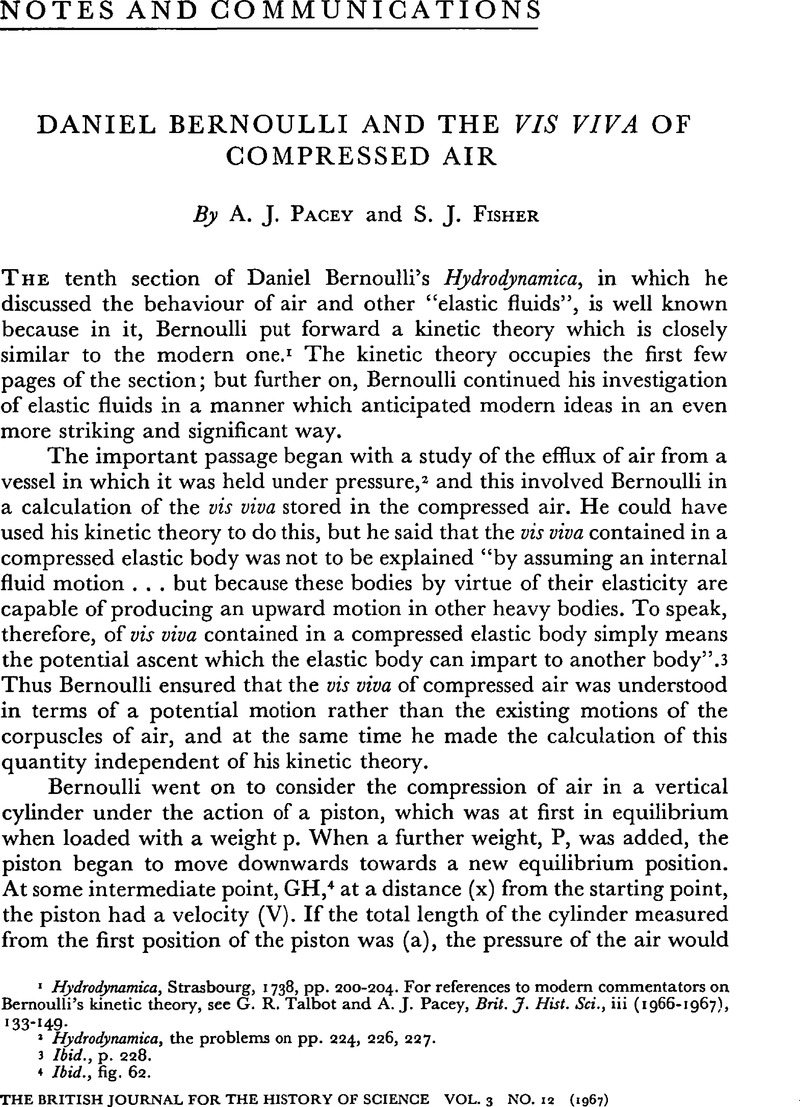Article contents
Daniel Bernoulli and the Vis Viva of Compressed Air
Published online by Cambridge University Press: 05 January 2009
Abstract

- Type
- Notes and Communications
- Information
- Copyright
- Copyright © British Society for the History of Science 1967
References
1 Hydrodynamica, Strasbourg, 1738, pp. 200–204Google Scholar. For references to modern commentators on Bernoulli's kinetic theory, see Talbot, G. R. and Pacey, A. J., Brit. J. Hist. Sci., iii (1966–1967), 133–149.CrossRefGoogle Scholar
2 Hydrodynamica, the problems on pp. 224, 226, 227.Google Scholar
3 Ibid., p. 228.
4 Ibid., fig. 62.
5 Ibid., p. 229.
6 Ibid., p. 164.
7 Carnot, Lazare, Principes fondamentaux de l'equilibre et du mouvement (Paris, 1803), p. 37.Google Scholar
8 MacQuorn Rankine, W. J., Miscellaneous Scientific Papers (London, 1881), p. 207.Google Scholar
9 Ibid., p. 230.
10 Thomson, William and Tait, P. G., Elements of Natural Philosophy, part i (Oxford, 1873), pp. 1, 53–54.Google Scholar
11 Encyclopaedia Britannica, 3rd edn. article “Steam”, vol. xvii (1797), 770Google Scholar. “Mechanical energy” was here used to mean work.
12 Leslie, J., An Experimental Enquiry into the Nature and Propagation of Heat (London, 1804), pp. 454, 457, 459, 460, 472, 477, 480, 483, 500 and 501Google Scholar. These references all occur in the section on radiant heat and light, where phrases like “the energy of the incident rays” (pp. 454 and 459) are used in a general and qualitative sense. We are indebted to Dr. G. R. Talbot for this information.
13 Edinburgh Review, xii (1808), 130 ffGoogle Scholar. “Energy” is here suggested as a new term for momentum.
14 Young, Thomas, Course of Lectures on Natural Philosophy (London, 1807), vol ii, p. 52.Google Scholar
15 Rankine, , op. cit., p. 230.Google Scholar
16 Hydrodynamica. op. cit., pp. 231–232, 234–243.Google Scholar
17 Ibid., p. 232.
18 Jamieson, Andrew, A Text-book on Steam and Steam Engines (London, 1897), pp. 14–19.Google Scholar
19 MS. in the Royal Institution of Cornwall, Truro, dated from letters in the same collection which were written in 1791. Davies Gilbert was in 1790 called Davies Giddy. He adopted his wife's surname in 1817, and we refer to him consistently by this later and better-known name.
20 The relationship of Davies Gilbert and Hornblower is dealt with by Todd, A. C., Newcomen Soc. Trans., xxxii (1959–1960), pp. 1–13CrossRefGoogle Scholar. The invention of the indicator diagram, about which we have had valuable advice from Dr. D. S. L. Cardwell, is dealt with by Dickenson, H. W., A Short History of the Steam Engine (Cambridge, 1938), p. 85.Google Scholar
21 Encyclopaedia Britannica, 3rd edn. article “Steam”, vol. xvii (1797), pp. 765–766, 771.Google Scholar
22 Phil. Trans. (1827), pp. 33–34.Google Scholar
23 Gilbert used the word “efficacy” in 1790, and in 1827 he was trying to establish “efficiency” as a term for available energy or work. The calculation given here refers only to the part of the stroke in which the steam expands. The work done during the whole stroke is [1+loge(1+x)].
24 He had probably not seen Hydrodynamica, but in 1790 he referred to “the ninth volume of the Memoirs of Berlin” where Sulzer commented on Bernoulli's explanation of reasons why Boyle's law is not exactly obeyed (Hist, et Mém, de l'Acad. Roy. Sci., Berlin, ix, 1753 [1755], 114–129)Google Scholar
- 4
- Cited by




